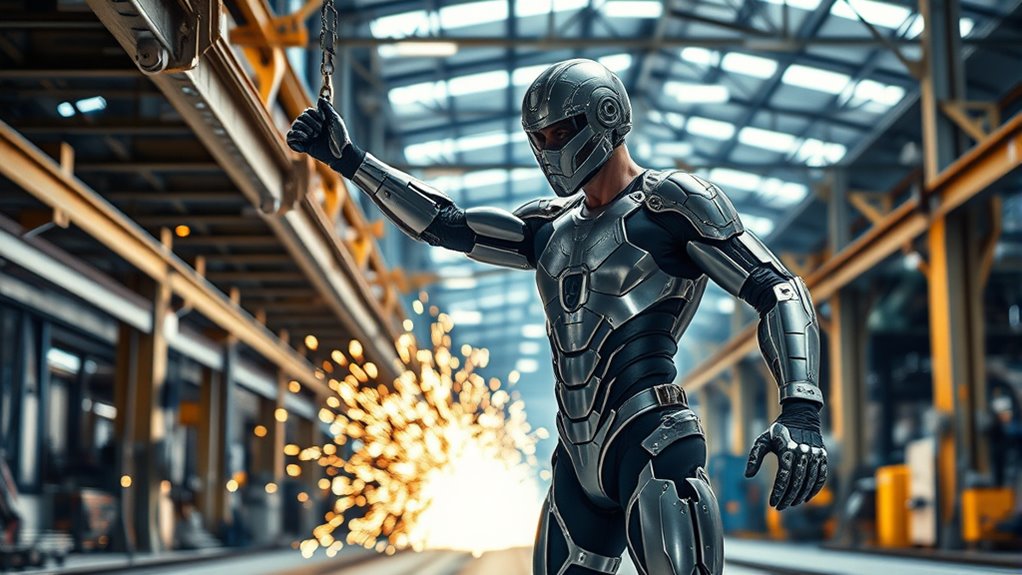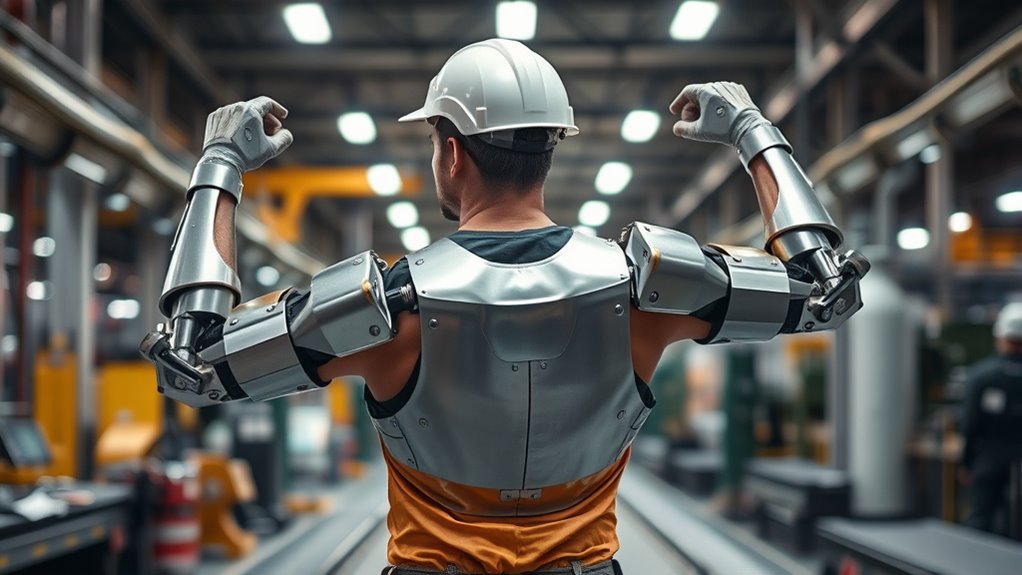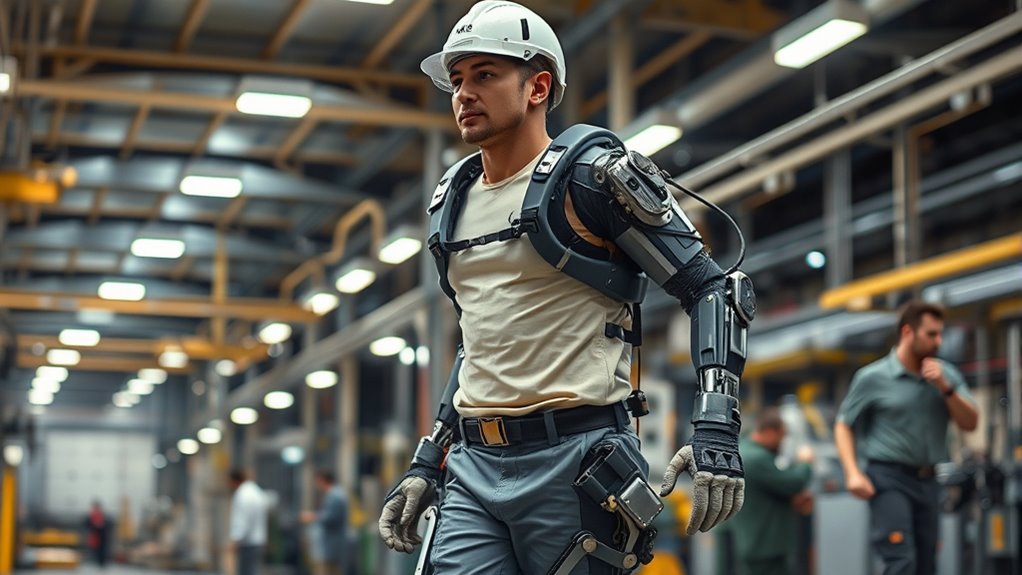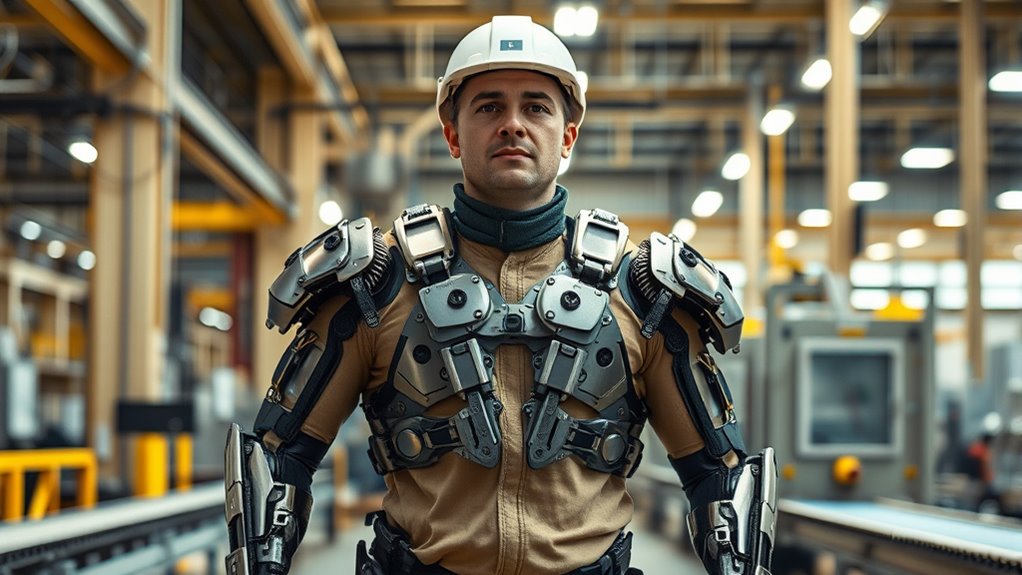Industrial exoskeletons transform workers into superheroes by enhancing strength, endurance, and precision during tough tasks. They support proper posture, reduce fatigue, and lower injury risks, making demanding work more manageable. With lightweight materials and smart sensors, these devices seamlessly adapt to your movements, offering a natural feel. As technology advances, future models will become even smarter and more intuitive, helping you understand how you can access your true potential in the workplace.
Key Takeaways
- Exoskeletons amplify worker strength and endurance, enabling them to perform superhuman tasks with less fatigue.
- Advanced ergonomic designs support natural movement, making workers feel more agile and capable.
- Integrated sensors and AI help exoskeletons anticipate actions, providing seamless, superhero-like responsiveness.
- By reducing injury risk and improving efficiency, exoskeletons empower workers to handle previously impossible workloads.
- The evolution of smart, connected exoskeletons transforms human capability, giving workers superpower-like performance in industrial settings.
The Evolution of Industrial Exoskeletons

The evolution of industrial exoskeletons reflects a rapid advancement in technology aimed at enhancing worker safety and productivity. Early designs focused on basic mechanical support, but modern exoskeleton design emphasizes adaptability and comfort. Engineers now prioritize ergonomic considerations to guarantee these devices fit naturally and reduce strain during extended use. This shift has led to lightweight materials, adjustable components, and intuitive controls, making exoskeletons more practical for daily work. As technology progresses, exoskeletons are becoming more integrated with sensors and smart features, improving responsiveness and user experience. Understanding credit card security measures and cybersecurity best practices is essential as these devices become more connected and data-driven. Your focus on ergonomic considerations ensures that these wearable devices support your movements seamlessly, minimizing fatigue and injury risk. This evolution marks a significant step toward making exoskeletons essential tools for industrial workers.
How Exoskeletons Enhance Worker Performance

Modern exoskeletons are transforming how you perform demanding tasks by amplifying strength, endurance, and precision. They provide ergonomic improvements, allowing you to maintain proper posture and reduce strain during heavy lifting or repetitive motions. By supporting your body’s natural movements, exoskeletons help minimize fatigue, enabling you to work longer without discomfort or exhaustion. This reduction in fatigue not only boosts productivity but also lowers the risk of injuries caused by overexertion. With the added support, you can focus more on your tasks rather than worrying about physical limitations. Additionally, store hours information can help workers plan their shifts better and maximize the benefits of using exoskeletons during their workdays. Overall, exoskeletons enhance your performance by making physically demanding work more manageable, comfortable, and efficient, empowering you to achieve higher productivity levels while maintaining your well-being.
Key Types of Exoskeletons Used in Industries

Various types of exoskeletons are tailored to meet specific industrial needs, each designed to support different parts of the body and types of work. You’ll find upper-body exoskeletons that reduce strain on your arms and shoulders during overhead tasks, while lower-body models assist with lifting and carrying heavy loads. Some exoskeletons prioritize exoskeleton customization, allowing adjustments for your body size and task requirements to maximize comfort and effectiveness. Ergonomic design is a key focus, ensuring the devices align with natural movements and reduce fatigue. You can choose between passive exoskeletons, which use springs and elastic materials, and active models powered by motors or pneumatics. These key types help optimize productivity and safety across various industries, adapting to your specific work environment. Incorporating Quality Assurance practices into the development and deployment of exoskeletons ensures they meet safety standards and perform reliably in demanding industrial settings.
Benefits and Challenges of Implementing Exoskeletons

Implementing exoskeletons in the workplace can markedly boost productivity and reduce injury risk, but it also presents notable challenges. While ergonomic improvements help lessen fatigue and strain, safety enhancements depend on proper integration and training. You might face issues like device comfort, maintenance costs, or resistance from workers hesitant to adopt new technology. Additionally, selecting the right safety features is crucial for effective implementation.
The Future of Human-Exoskeleton Collaboration

As technology advances, the collaboration between humans and exoskeletons is poised to become more seamless and intuitive. You’ll experience improved robot-human synergy, where exoskeletons anticipate your movements and adapt in real-time, enhancing productivity and safety. Ergonomic innovation drives this progress, designing devices that feel natural and reduce fatigue during long shifts. Future exoskeletons will likely integrate smarter sensors and AI, allowing for smoother interactions and personalized support. This evolution will make your work easier, less strenuous, and more efficient. As these systems become more intuitive, you’ll find yourself working alongside technology more effortlessly, turning complex tasks into manageable ones. The future of human-exoskeleton collaboration promises a new era where human capability is amplified through smarter, more ergonomic solutions driven by ergonomic innovation.
Frequently Asked Questions
What Are the Safety Concerns Associated With Exoskeleton Use?
When using exoskeletons, you should be aware of safety concerns like privacy issues, since many devices collect data on your movements. Proper training is essential to prevent injuries and guarantee correct use, but it can be time-consuming. You need to follow safety protocols carefully, stay aware of potential malfunctions, and address privacy concerns to protect your personal information while maximizing the benefits of these devices.
How Do Exoskeletons Impact Long-Term Worker Health?
You might wonder how exoskeletons affect your long-term health. They can promote ergonomic improvements by reducing strain on your muscles and joints, helping protect your musculoskeletal health. However, if misused or poorly fitted, they could cause discomfort or unintended stress over time. Proper training and regular adjustments are essential to guarantee these devices support your body safely, ultimately enhancing your well-being during long-term use.
What Industries Are Most Likely to Adopt Exoskeleton Technology Soon?
Imagine stepping into a future where industries embrace robotic integration like a trusted partner. You’ll see manufacturing, logistics, and construction leading the charge, as they prioritize ergonomic design to reduce strain. These sectors are most likely to adopt exoskeleton technology soon, transforming workplaces into safer, more efficient environments. By integrating this gear, you’ll help revolutionize work, making heavy lifting easier and preventing injuries before they happen.
Are There Any Ethical Considerations in Deploying Exoskeletons at Work?
When considering deploying exoskeletons at work, you should think about ethical concerns like worker autonomy and privacy. You might worry that these devices could pressure you to work harder or longer, reducing your control over your workload. Privacy concerns also arise if your movements and data are monitored constantly. It’s important that companies establish clear policies to safeguard your rights and ensure the technology is used responsibly and ethically.
How Affordable Are Industrial Exoskeletons for Small and Medium Businesses?
When considering the affordability of industrial exoskeletons for small and medium businesses, you’ll find that cost reduction and technology scalability play key roles. As technology advances and scales up, prices tend to drop, making exoskeletons more accessible. While initial investments may seem steep, ongoing innovations are making these devices increasingly affordable, helping you improve safety and productivity without breaking the bank.
Conclusion
Imagine strapping on an exoskeleton and suddenly feeling like you’ve gained superpowers, effortlessly lifting heavy loads. Just like a superhero’s cape, these devices amplify your strength and endurance. As industry adoption grows, you’ll find yourself breaking limits you once thought impossible. Embracing exoskeletons isn’t just about technology — it’s about transforming you into a worker who’s stronger, safer, and more unstoppable. The future belongs to those who harness these tools to elevate human potential.










